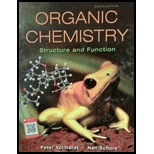
Concept explainers
(a)
Interpretation: The hybridization of the orbitals having unshared pair of electrons in
Concept Introduction: The hybridization is defined as mixing of atomic orbitals. The new hybrid orbitals are formed equal in the number of atomic orbitals involved in the mixing.
(b)
Interpretation: The relative abilities of
Concept Introduction: The hybridization is defined as mixing of atomic orbitals. The new hybrid orbitals are formed equal in the number of atomic orbitals involved in the mixing.
(c)
Interpretation: The given species needs to be ranked in order of the acid strength.
Concept Introduction: The species which can form stable negative charge will be most acidic because it will readily donate hydrogen atom to attain stability.
Want to see the full answer?
Check out a sample textbook solution
Chapter 1 Solutions
EBK ORGANIC CHEMISTRY
- The specific rotation of a sample depends upon measured angle of rotation, the density of the sample, and the pathway length of the light. True Falsearrow_forwardConsider the molecule A,B, C and D shown below, (1 x 4) Br NH2 A OH Br 边 H B C D 1. Assign the R/S configuration to each chiral center and identify by circling all the chiral centers. 2. Draw an image for the enantiomer of each of the compounds A, B, C and D.arrow_forwardCould you crystallize one enantiomer of mandelic acid from a racemic mixture (using the typical achiral solvents found in our lab) without preparing a diastereomeric salt? Why or why not? No, because both enantiomers have the same solubility in achiral solvents. than the other. ооо Yes, because one enantiomer has a higher melting point No, because both enantiomers are liquids. Yes, because one enantiomer is more crystalline than the other.arrow_forward
- If the literature value of specific rotation for a chiral compound is -53.6°, what is the enantiomeric excess of a compound with a measured specific rotation of -40.5°?arrow_forwardThe process to determine the configuration, starts by placing the lowest priority substituent toward the back. If the substituents pointing forward decrease in priority in a clockwise order, the configuration is S. If the substituents decrease in priority in a counterclockwise order, the configuration is R. True Falsearrow_forwardIn the drawing area below, create a hemiacetal with 1 hydroxyl group, 1 methoxy group, and a total of 3 carbon atoms. Click and drag to start drawing a structure. Explanation Check Х PO 18 Ar B © 2025 McGraw Hill LLC. All Rights Reserved. Terms of Use | Privacy Center | Accessibilityarrow_forward
- Predict the product of the reaction below (3 pts). hydrazine Ph H₂NNH2 KOH Write the mechanism for the above reaction using curved arrows to show electron movements. show all intermediates in the process (7 pts).arrow_forward↓ Feedback (8/10) Draw the major product of this reaction. Ignore inorganic byproducts. Incorrect, 2 attempts remaining N H3O+ 0 × Select to Draw + V Retryarrow_forward2. Calculate the branching ratio of the reaction of the methyl peroxy radical with either HO, NO 298K) (note: rate constant can be found in the tropospheric chemistry ppt CH,O,+NO-HCHO+HO, + NO, CH₂O+HO, CH₂00H +0₂ when the concentration of hydroperoxyl radical is DH01-1.5 x 10 molecules and the nitrogen oxide maxing ratio of 10 ppb when the concentration of hydroperoxyl radicalis [H0] +1.5x10 molecules cm" and the nitrogen oxide mixing ratio of 30 p Under which condition do you expect more formaldehyde to be produced and whyarrow_forward
- Indicate the product of the reaction of benzene with 1-chloro-2,2-dimethylpropane in the presence of AlCl3.arrow_forwardIn what position will N-(4-methylphenyl)acetamide be nitrated and what will the compound be called.arrow_forwardDATA: Standard Concentration (caffeine) mg/L Absorbance Reading 10 0.322 20 0.697 40 1.535 60 2.520 80 3.100arrow_forward
 Chemistry: Principles and ReactionsChemistryISBN:9781305079373Author:William L. Masterton, Cecile N. HurleyPublisher:Cengage Learning
Chemistry: Principles and ReactionsChemistryISBN:9781305079373Author:William L. Masterton, Cecile N. HurleyPublisher:Cengage Learning Chemistry: The Molecular ScienceChemistryISBN:9781285199047Author:John W. Moore, Conrad L. StanitskiPublisher:Cengage Learning
Chemistry: The Molecular ScienceChemistryISBN:9781285199047Author:John W. Moore, Conrad L. StanitskiPublisher:Cengage Learning Chemistry: Principles and PracticeChemistryISBN:9780534420123Author:Daniel L. Reger, Scott R. Goode, David W. Ball, Edward MercerPublisher:Cengage Learning
Chemistry: Principles and PracticeChemistryISBN:9780534420123Author:Daniel L. Reger, Scott R. Goode, David W. Ball, Edward MercerPublisher:Cengage Learning Chemistry & Chemical ReactivityChemistryISBN:9781337399074Author:John C. Kotz, Paul M. Treichel, John Townsend, David TreichelPublisher:Cengage Learning
Chemistry & Chemical ReactivityChemistryISBN:9781337399074Author:John C. Kotz, Paul M. Treichel, John Townsend, David TreichelPublisher:Cengage Learning



